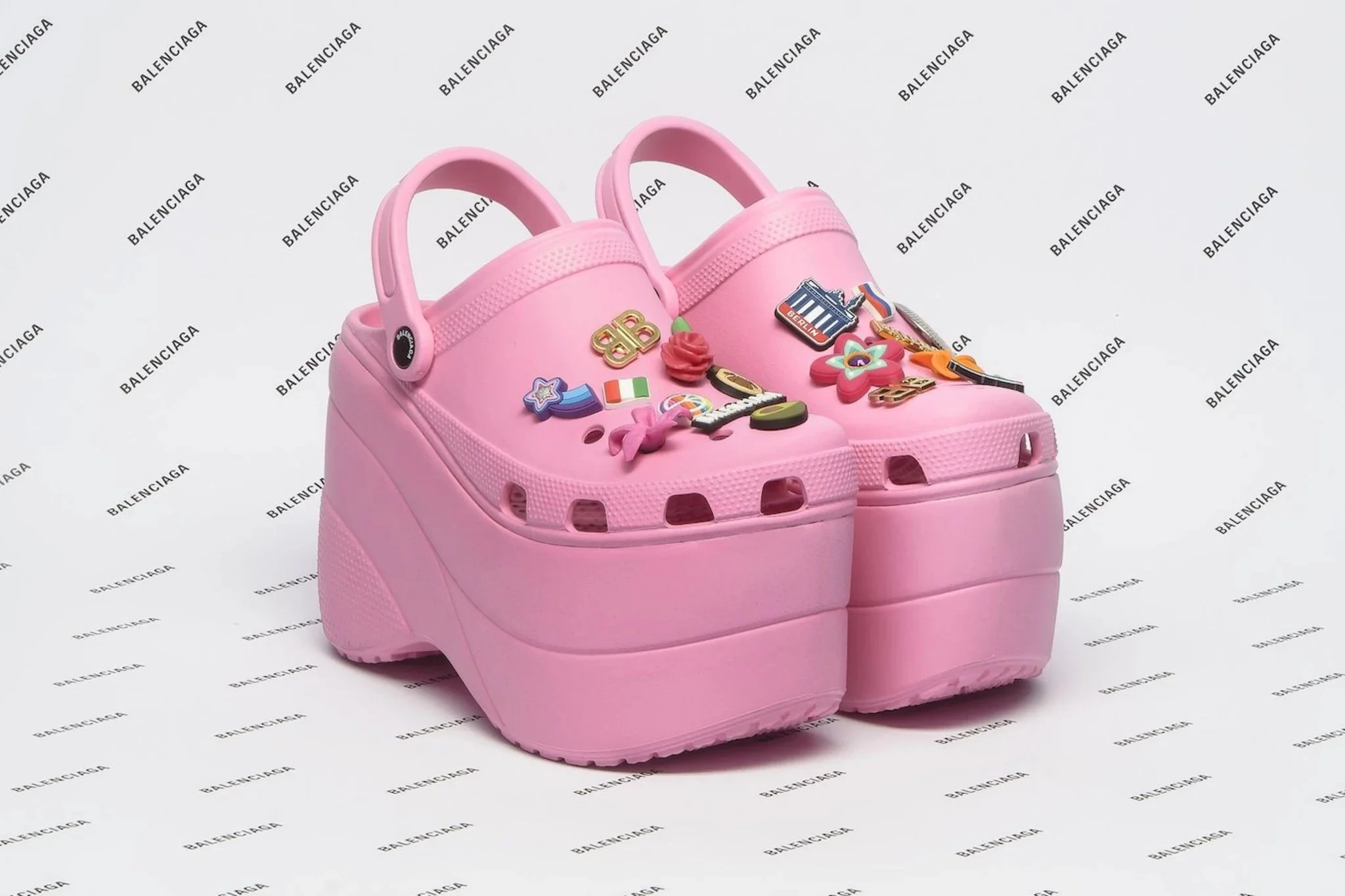From Hashtag to Handbag: The Memeification of Luxury
It is impossible to scroll through the latest in Spring/Summer ‘25 style without seeing Loewe’s signature tomato clutch. At first glance, the Spanish fashion house’s fire engine-red leather purse purely reflects the season: a beautiful, heirloom tomato-inspired accessory to celebrate summer’s bounty, perfectly ripe for the picking.
For those who are not chronically online, this handbag appears to be another fresh, whimsical design from the then-Creative Director Jonathan Anderson, whose tongue-in-cheek approach reawakened the formerly sleepy heritage brand. While a real-life vegetable did indeed inform the clutch’s design, it was not an idea that came to the designer organically, but rather, through a viral post on X.
On June 6, 2024, X user Gianna Rosina (@giannarosinaa) shared an image of the exterior and cross-section of a ruffled red heirloom tomato, admiring its distinctive pleats. In response, Connor Downey (@homocowboi) reposted with the comment, “This tomato is so Loewe I can’t explain it.” Little did he know that this fleeting thought would be immortalized by Anderson as the season’s hottest accessory. A mere five days after reposting the image himself, the designer shared a behind-the-scenes video of the handbag in progress, captioned, “Loewe meme to reality.”
Connor Downey’s X repost and comment was responsible for sparking the Loewe tomato handbag design. Image source: https://taustralia.com.au/loewes-latest-accessory-is-crafted-from-upcycled-leather/
While Loewe’s admiration for the humble tomato predates the meme—as embodied by their tomato leaf soap, room spray, and candle—the house’s €3,000 red leather fruit-shaped clutch owes everything to a relatively unknown digital fan. The brand is credited as inspiring an aesthetic described on TikTok as ‘Tomato Girl Summer.’
Loewe’s Heirloom Tomato Clutch Bag. Image source: https://www.bonappetit.com/story/loewe-tomato-bag?srsltid=AfmBOopeoKFgYbGXgZp4RwrIG9hSnpCptftoQLrmDX2DR_OI9mEEtREF
Loewe is part of the trend of luxury brands bringing user-generated ideas to life, and is by no means the first major player to do so. More and more, brand loyalists and pop culture enthusiasts are informing designs, and the ‘memeification’ of luxury does not appear to be slowing down.
In March 2017, Gucci launched the #TFWGucci social media campaign to promote the debut of its Le Marché des Merveilles watch collection. A play on “That Feel When”, #TFWGucci aimed to capitalize on Millennial and Gen Z’s obsession with the trending phrase by joining the conversation. For this ‘collaborative meme project’, the Italian fashion brand partnered with artists, photographers, and content creators to design memes featuring their new watches and shared on Gucci’s account and a dedicated micro-site.
Content creators’ posts from the #TFWGUCCI campaign
Widely disseminated online, Loewe and Gucci’s launches have received criticism, and both call into question ownership and the role of digital creators today. Who should receive credit for the Loewe tomato handbag, and was Downey ever credited or compensated? Are user-generated ideas, rather than a Creative Director, going to one day shape the face of luxury? Are these digital-first approaches in line with a heritage brand’s identity—particularly #TFWGucci’s artists, whose aesthetics were not very aligned with the fashion house—or simply an attempt to engage younger, social media-savvy consumers? In an age where creative directors are consistently jumping from one company to another, have the consumers and their social platforms begun to understand luxury brands’ identities better than the brands themselves?
While the industry’s recent internet-forward approach is successful in reaching the next generation of luxury consumers and fostering social media buzz, it has been met with mixed reviews. There is a concern that products are designed with press exposure, instead of brand heritage and craftsmanship, in mind. Cultural Strategist Alison Ho of London-based trend forecasting company WGSN notes: “Viral products will continue to help brands build hype and drive impactful moments that accelerate cultural conversations and cut through during an attention recession, but are not likely to have lasting power.” Others feel that whimsical, meme-able products, such MSCHF’s oversized, cartoonish red boots, were a welcomed change, providing relatability and lightness to an industry that is traditionally viewed as elitist and exclusionary.
MSCHF’s viral big red boots originally retailed $350 and since selling out are available for resale at nearly $1,500 on Stock X. Image Source: https://jingdaily.com/posts/viral-memes-and-usd1m-handbags-is-luxury-fashion-now-a-spectator-sport
While some creative directors lean into consumers’ ideas and feedback to shape their collections, other major retailers have taken the opposite approach; instead of relying on user-generated content and advertising campaigns produced by external creators, luxury brands such as Balenciaga make their own meme-able products.
A Creative Director known for his renegade, pop culture-inspired aesthetic that blurs the lines between streetwear and high fashion, Demna Gavasalia has been credited for starting the trend of celebrities and major houses collaborating with shoewear company, Crocs. Known to don Crocs himself as everyday wear since Summer 2017, Demna launched his own co-branded pair on the runway at Balenciaga’s Spring/Summer 2018 show. Sharing the impetus behind the partnership, he says, “It’s a very innovative shoe. It’s light, it’s a one-piece foam mould and to me these kind of techniques and working with these kind of materials is very Balenciaga. In the future you will be able to 3-D print them at home because they are all one piece.”
Balenciaga’s buzzy platform Crocs, first introduced in the Spring/Summer 2018 runway show. Image Source: https://www.complex.com/style/a/lei-takanashi/best-crocs-collaborations-ranked
A utilitarian shoe that prioritizes function over form, Crocs are notoriously despised by the fashion set. Balenciaga’s debut version is offered in a range of colors—from steel gray to bubblegum pink to school-bus yellow—and features a 10cm high platform and whimsical gibbits. A true shock to the industry that issued an audible gasp at fashion week, the Balenciaga Crocs were met with overwhelming delight, becoming a global bestseller, despite the scores of memes mocking them online. Originally offered at $850, the platforms sold out before hitting stores, and today resell for a staggering $1,800.
Describing fashion’s initial repulsion to the foam shoes, Demna shares,“People always get triggered by these types of products, when really there are so many ugly products out there that people don’t question. But when it’s something to do with Crocs, everyone loses their minds.” Online consumer critiques included vomiting emojis and comments such as “Every day we stray further from god’s light.”
With the influence of social media and preoccupation with virality, the introduction of Balenciaga Crocs is inevitable, as Millenials accounting for 70% of Balenciaga’s sales. The collaboration did not stop there. For the Spring/Summer 2022 collection, Demna introduced yet another viral model: the heeled Croc, available in bright green and black. Retailing at $625, the heels were heralded by Vogue journalist Liana Satenstein as the house’s ’ugliest shoe yet’ but also their most comforable, asserting that they are “a sure way to never get laid again.”
Balenciaga’s Heeled Crocs, introduced Spring/Summer 2022.
Source: https://www.harpersbazaar.com/uk/fashion/a36694167/crocs-balenciaga-high-heel/.
Instagram influencer and fashion commentator Hanan Besovic of @ideservecouture is critical of houses creating their own viral content, sharing, “Luxury brands will create memes that paint them in the best possible light, but those memes often look like an obvious setup. They are not willing to be in on the joke, which makes a huge difference.” He asserts that Gen Z is repelled by anything that feels “forced” or “does not come organically”, instead believing that virality should be initiated by consumers, rather than the brands themselves. He states, “If something goes viral, or has a potential for it to be memed, the luxury sector should let the internet do its thing without interfering.”
Does the luxury’s memification and willingness to engage in online cultural conversation foster cross-generational accessibility to an otherwise ‘if you know, you know’ industry? Or is it simply a series of off-brand, meme-bait products designed solely to maximize brand exposure? Only time—and fashion’s hungry digital audiences—will tell.
Madeline Wheeler
Contributing Writer, MADE IN BED







